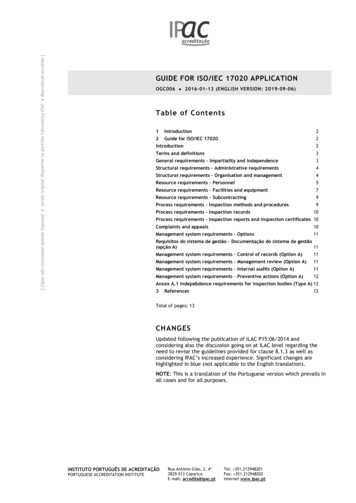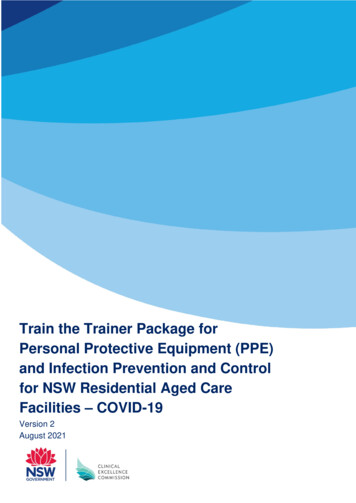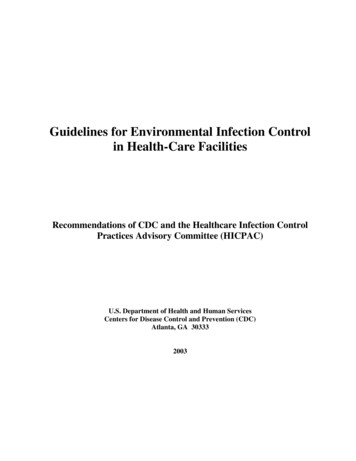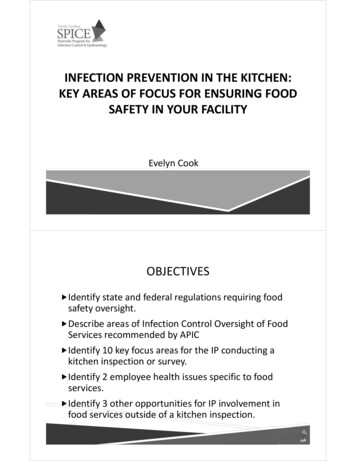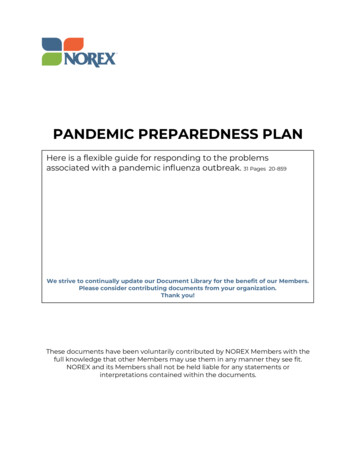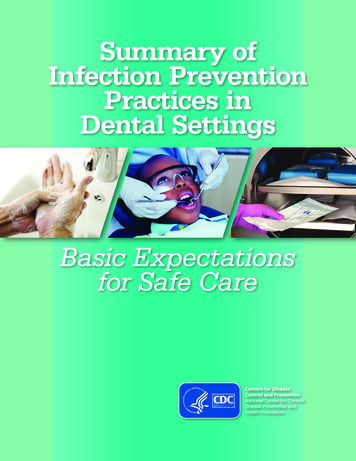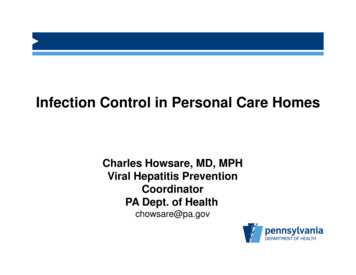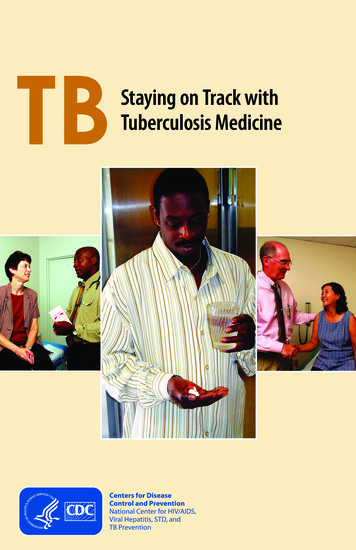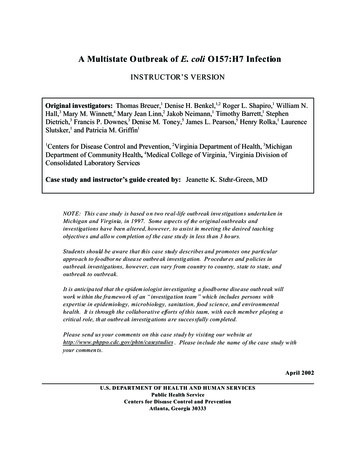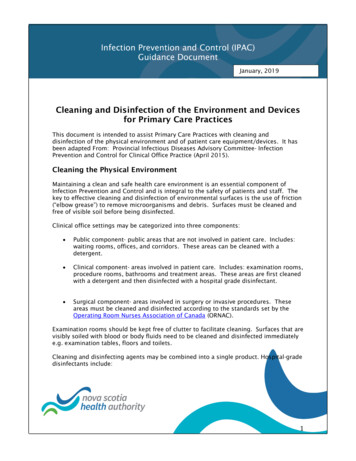
Transcription
Infection Prevention and Control (IPAC)Guidance DocumentJanuary, 2019Cleaning and Disinfection of the Environment and Devicesfor Primary Care PracticesThis document is intended to assist Primary Care Practices with cleaning anddisinfection of the physical environment and of patient care equipment/devices. It hasbeen adapted From: Provincial Infectious Diseases Advisory Committee- InfectionPrevention and Control for Clinical Office Practice (April 2015).Cleaning the Physical EnvironmentMaintaining a clean and safe health care environment is an essential component ofInfection Prevention and Control and is integral to the safety of patients and staff. Thekey to effective cleaning and disinfection of environmental surfaces is the use of friction(“elbow grease”) to remove microorganisms and debris. Surfaces must be cleaned andfree of visible soil before being disinfected.Clinical office settings may be categorized into three components: Public component- public areas that are not involved in patient care. Includes:waiting rooms, offices, and corridors. These areas can be cleaned with adetergent. Clinical component- areas involved in patient care. Includes: examination rooms,procedure rooms, bathrooms and treatment areas. These areas are first cleanedwith a detergent and then disinfected with a hospital grade disinfectant. Surgical component- areas involved in surgery or invasive procedures. Theseareas must be cleaned and disinfected according to the standards set by theOperating Room Nurses Association of Canada (ORNAC).Examination rooms should be kept free of clutter to facilitate cleaning. Surfaces that arevisibly soiled with blood or body fluids need to be cleaned and disinfected immediatelye.g. examination tables, floors and toilets.Cleaning and disinfecting agents may be combined into a single product. Hospital-gradedisinfectants include:1
Infection Prevention and Control (IPAC)Guidance Document Chlorine 5.25% Sodium hypochlorite at 50,000 parts per million (i.e. 1:50dilution of household bleach)Quaternary Ammonium compounds (QUATs)Hydrogen Peroxide Enhanced Action FormulationHospital-grade cleaning and disinfection products must: have a drug identification number (DIN) from Health Canadabe used according to the manufacturer’s recommendations for dilution,temperature and contact timebe used according to the product’s Material Safety Data Sheet (MSDS)Frequency of Cleaning in the Physical Environment:Clean between patientsClean at the end of the dayand when visibly soiledClean according to fixedschedule and when visiblysoiledBeds/examination tableBathroomsTransport equipment i.e.wheelchairsVacuuming CarpetsAppliances (refrigerators,microwaves, coffeemakers)Chairs, couchesBaseboardsDoorknobsSteam cleaning of carpetsFloorsCeilings and air ventsLight switchesMirrorsFurnishings in officespaces (desks, bookcases,cabinets)Overbed lamps and lightsIce machinesTablesLockersTelephonesPrivacy curtainsScalesTelevisions2
Infection Prevention and Control (IPAC)Guidance DocumentWall mounted items (soapdispensers, paper towelholders, glove box holder)WallsWindows, window sills andwindow coveringsCleaning and Disinfection/Sterilization of MedicalEquipment/DevicesMedical equipment and devices used in the provision of care to patients must becapable of being cleaned, disinfected and/or sterilized between uses. The minimumlevel of reprocessing is based on Spaulding’s classification of Medical Equipment:ClassUseMinimum level ofReprocessingExamplesCriticalEnters sterile bodysite including thevascular systemCleaning followedby sterilizationSurgicalinstrumentsBiopsy instrumentsPodiatry equipmentSemi-criticalNon-CriticalComes in contactwith non-intact skinor mucousmembranes butdoes not penetratethemCleaning followedby high leveldisinfectionTouches only intactskin and notmucousmembranes or doesnot directly touchthe patientCleaning followedby low-leveldisinfectionSterilization ispreferredVagina speculumAnaesthesiaequipmentTonometerECG machinesOximetersBlood Pressure CuffStethoscopesSingle-use Medical Devices are not to be reprocessed.3
Infection Prevention and Control (IPAC)Guidance DocumentThe manufacturer’s information for decontamination and reprocessing must befollowed. These written procedures for cleaning and disinfection/sterilization ofequipment and devices should be kept near the reprocessing area for reference.Procedures must be reviewed and revised regularly.The reprocessing method and products to be used will depend on the intended use ofthe equipment/device and the potential risk of infection. The process and productsused for cleaning, disinfection and or sterilization must be compatible with theequipment/devices. The Manufacturer should be able to provide you with a list ofcompatible products and methods.Equipment reprocessing is to occur in an area segregated from patients and clean areas.There must be a clearly designated individual who is responsible for reprocessing.Transport of used medical equipment from the procedure area to the reprocessing areamust be done in a way to prevent contamination of the environment for example in acovered container. The transport containers must be cleaned after each use.Recommendations for cleaning medical equipment/devices include: Follow the instrument manufacturer’s guidelines for cleaning.Staff who handle and clean contaminated equipment/devices must wear facialprotection, gloves and a gown.Check the product expiry date before use.Clean the instrument as soon as possible after use so that organic material(blood, pus, mucous, feces, etc.) does not dry on it. If there will be a delay inreprocessing, soak the instrument in an approved instrument soaking solution.Clean instrument with an instrument detergent/enzymatic diluted according tomanufacturer’s directions, or alternatively in an ultrasonic washer. Pay specialattention to rough or porous surfaces, hinges, coils, valves, clamps or crevicesthat may harbor microorganisms.Clean instruments that have lumens with a brush, according to themanufacturer’s instructions. The brush must also be cleaned and disinfected.Ensure adequate exposure (contact) time between equipment/device and theproduct.Rinse the instrument with water after cleaning to remove residue that mightinterfere with the disinfectant/sterilant.Dry the instrument according to manufacturer’s instructions. Drying preventsdilution of the chemical disinfectants.Visually inspect the instrument after cleaning and prior todisinfection/sterilization to ensure cleanliness and integrity of the instrument.4
Infection Prevention and Control (IPAC)Guidance DocumentSterilization is the elimination of all disease-producing microorganisms includingspores. Sterilization is used on all critical medical equipment/devices and wheneverpossible semi-critical devices. Equipment/devices that are to be sterilized requirewrapping. Materials used for wrapping shall be prepared in a manner that will allowadequate air removal, steam penetration and evacuation to all surfaces. Plastic/peelpouches are easy to use, often with self-sealing closures and chemical indicator stripsand come in a variety of sizes that can accept single or small groups of instruments.The date should be marked on the product wrapping.The preferred method for decontamination of heat-resistant devices is steamsterilization. Pre-vacuum table top sterilizers are acceptable for clinic settings providingthey have regular preventative maintenance and cleaning preformed to assure theeffectiveness of the sterilizer. Unacceptable methods of disinfection/sterilizationinclude: dishwasher, boiling, ultraviolet irradiation, glass bead sterilizers, chemiclavesterilizers and microwave ovens.The sterilization process shall be monitored to ensure the integrity of the process. Alog book must be kept for each sterilizer load. Performance monitoring includesphysical, biological and chemical indicators. A procedure shall be established for therecall of improperly reprocessed medical equipment/devices.Steam sterilized packs must be subject to a drying cycle prior to handling and storage.Wrapped packs must be carefully stored in a clean, dry, dust free areas (i.e. closedshelves) not at floor level away from debris drains, moisture, sinks and vermin toprevent contamination and maintain sterility until the time of use.High Level Disinfection can be used for reprocessing semi-critical items that cannotwithstand sterilization. Disinfection does not destroy spores (i.e. Clostridium difficile)or prions. High level disinfectants such as: 2 per cent glutaraldehyde, 0.2 per centperacetic acid, and 0.55 per cent ortho-phthalaldehyde (OPA) must not be used inclinical offices due to the Occupational Health and Safety concerns with inappropriateventilation systems to protect against the toxic vapours.A 7 per cent hydrogen peroxide enhanced formulation may be used as it is does notproduce these vapours. This type of solution is often used for disinfecting foot careequipment.Low-level disinfection is utilized for non-critical equipment/devices that do not touchmucous membranes and only touch intact skin (e.g. stethoscopes, blood pressure cuffs,baby scales). Disinfectant wipes may be used for cleaning small non-critical itemsbetween patients (i.e. blood pressure cuff). Examples of Low-level disinfectants include:5
Infection Prevention and Control (IPAC)Guidance Document Hydrogen Peroxide Enhanced Action Formulation (0.5%)ChlorinesQuaternary Ammonium Compounds (QUATs) - not to be used to disinfectinstruments. May be used for equipment such as blood pressure cuffs,stethoscopes, surfaces, etc.If you have questions or concerns regarding the cleaning, disinfection and sterilizationof medical equipment and devices please contact your local NSHA Infection Preventionand Control Department or Medical Device Reprocessing Department for assistance.References:Ontario Agency for Health Protection and Promotion (Public Health Ontario), ProvincialInfectious Diseases Advisory Committee. Infection Prevention and Control for ClinicalOffice Practice. 1st Revision. Toronto, ON: Queen’s Printer for Ontario; April 2015.Ontario Agency for Health Protection and Promotion (Public Health Ontario), ProvincialInfectious Diseases Advisory Committee. Best practices for environmental cleaning forprevention and control of infections in all health care settings. 3rd ed. Toronto, ON:Queen’s Printer for Ontario; 2018.6
Infection Prevention and Control (IPAC)Guidance DocumentAppendix A: Recommended Minimum Cleaning and Disinfection Level andFrequency for common Medical EquipmentItemLevel of Cleaning andDisinfectionFrequencyBlood Pressure cuffCleaning and Low- levelDisinfectionBetween patientsVaginal SpeculumDisposable preferredDisposable orCleaning and High-levelDisinfectionBetween patientsDisposable preferredDisposable orCleaning and High-levelDisinfectionBetween patientsDisposable preferredDisposable orCleaning and SterilizationBetween patientsDopplerCleaning and Low-levelDisinfectionBetween patientsTympanic ThermometerCleaning and Low-levelDisinfectionBetween patientsCuretteCleaning and SterilizationBetween patientsKidney BasinCleaning and Low-levelDisinfectionBetween patientsNasal SpeculumSuture Removal (Tweezers,Forceps, Scissors)7
Infection Prevention and Control (IPAC)Guidance DocumentEar IrrigationBowl, 20cc syringe,collection deviceBowl- Cleaning and Lowlevel DisinfectionBetween patientsSyringe-Disposablepreferred. If reusablemust be Cleaned and Highlevel disinfected.ForcepsCleaning and SterilizationBetween patientsBaby scalesCleaning and Low-levelDisinfectionBetween patientsIUD tray and IUD DilatorCleaning and SterilizationBetween patientsHygienic Foot CareEquipment (e.g. filing ofcorns or callouses,trimming of nails, etc.)Cleaning and High-leveldisinfectionBetween patientsCleaning and SterilizationBetween patientsCleaning and Low-levelDisinfectionBetween patientsMetal files, corn and callusrasps, and nailclippers/cutters)Complex Foot CareEquipment (e.g.introduction of surgicalintervention including theepidermal, dermal, deepfascial, osseous structuresand other anatomicalstructures)Scissors, probes, andcurettes.Blade Handle8
Infection Prevention and Control (IPAC)Guidance DocumentOphthalmoscopeCleaning and Low-levelDisinfectionBetween patientsOtoscopeHandle- Cleaning and Lowlevel DisinfectionBetween patientsEar Speculum- Disposableor Cleaning and High-levelDisinfectionOAE Screening tipsDisposable or High-levelDisinfectionMonofilament (Intact Skinonly)Disposable or Cleaningand Low-level DisinfectionBetween patientsExam TableCleaning and Low-levelDisinfectionBetween patientsStaple RemoverDisposable preferredBetween patientsHemostatsOn intact skin- Cleaningand Low-level DisinfectionBetween patientsUn-intact skin- Cleaningand Sterilization9
produce these vapours. This type of solution is often used for disinfecting foot care equipment. Low-level disinfection is utilized for non-critical equipment/devices that do not touch mucous membranes and only touch intact skin (e.g. stethosco
